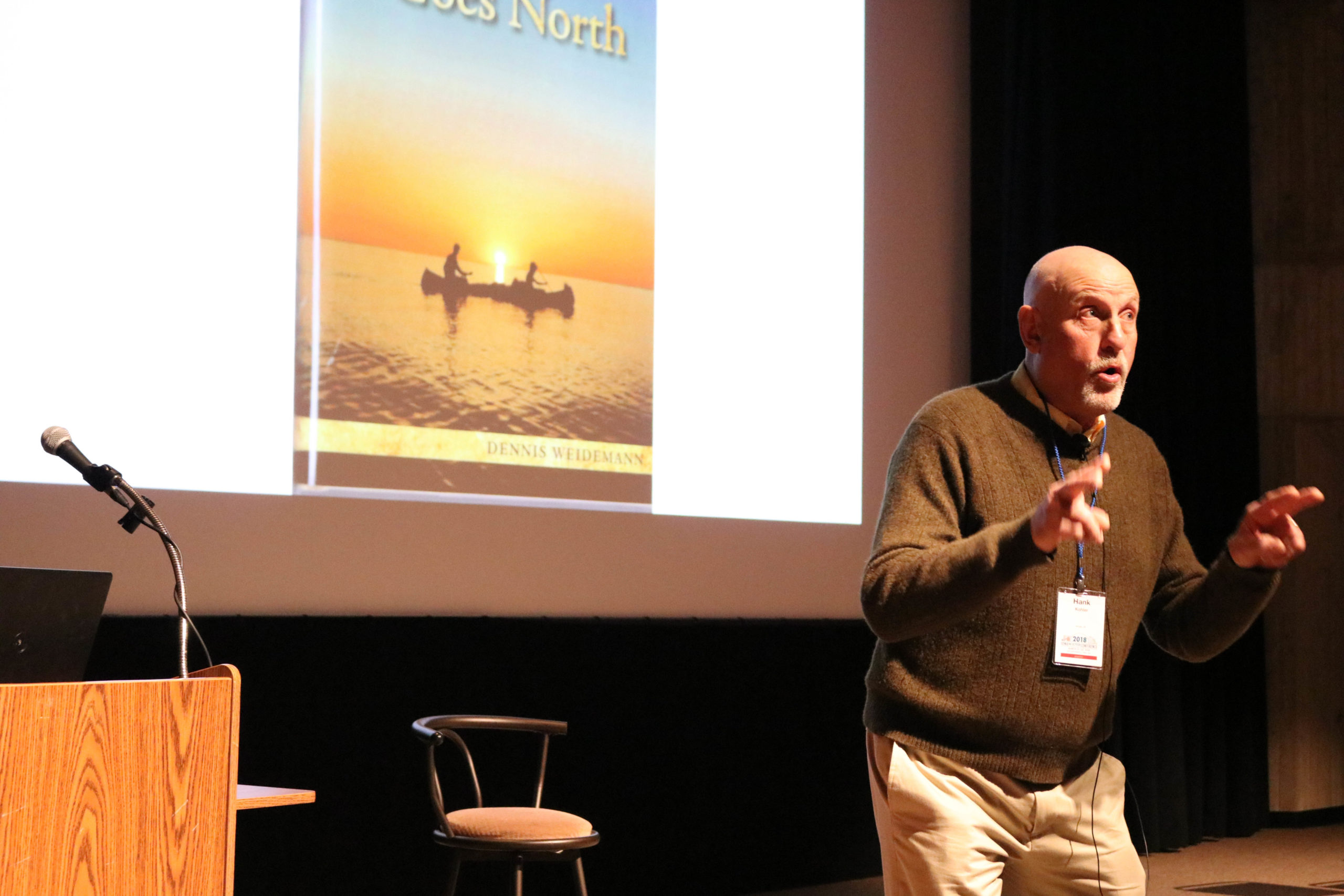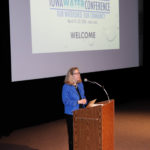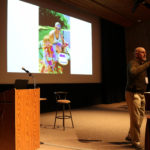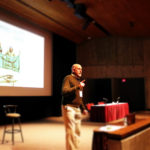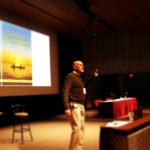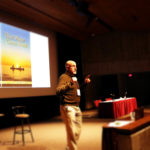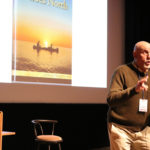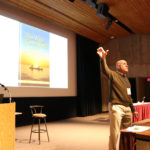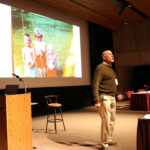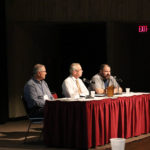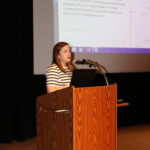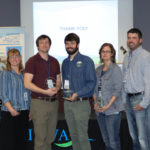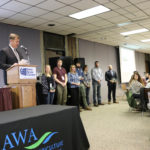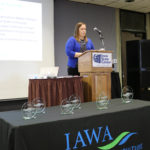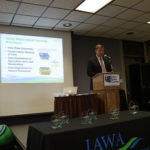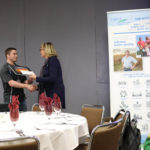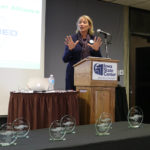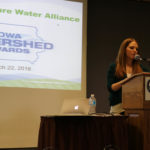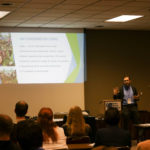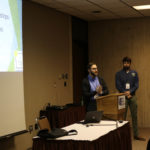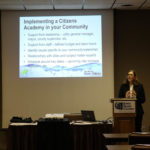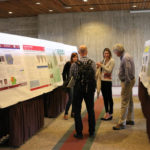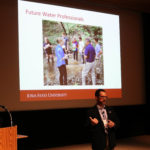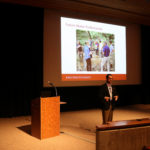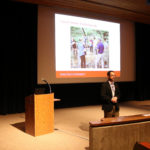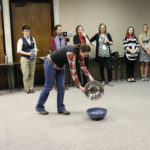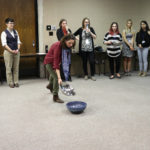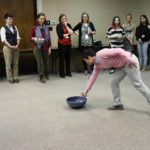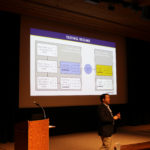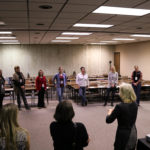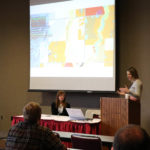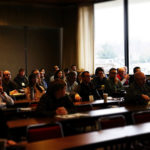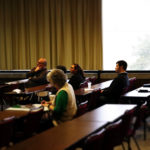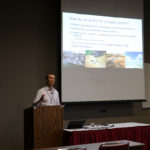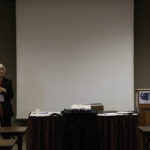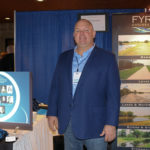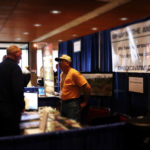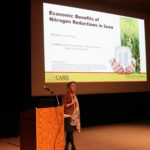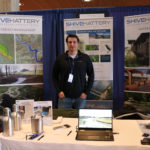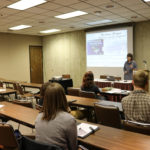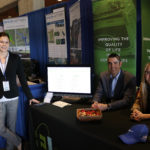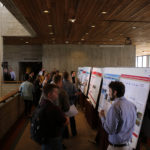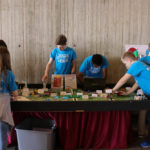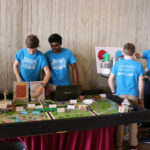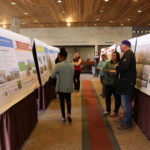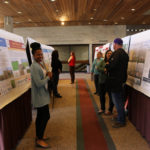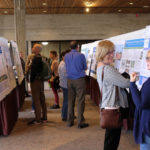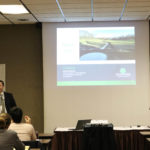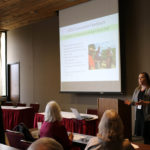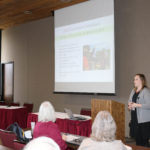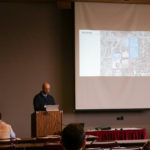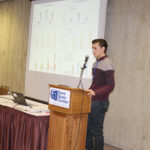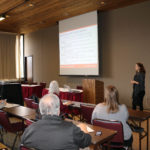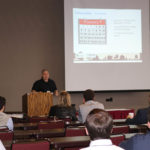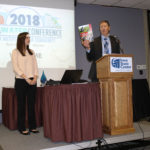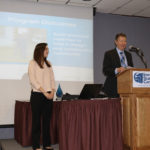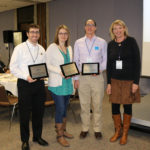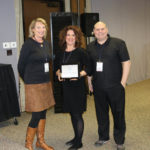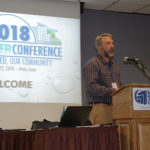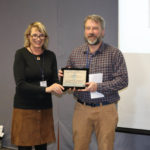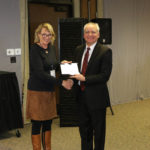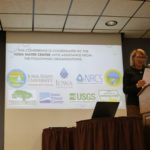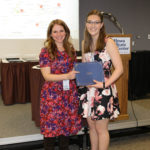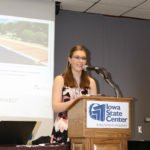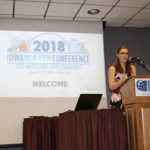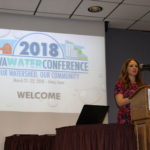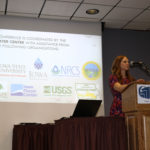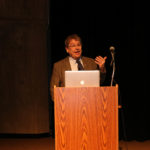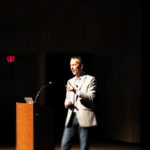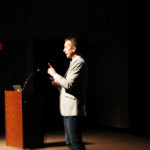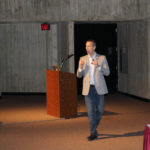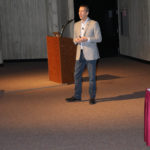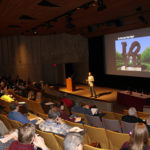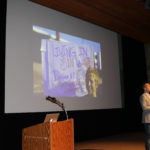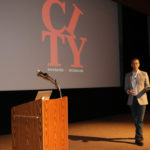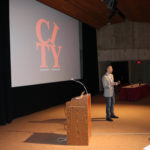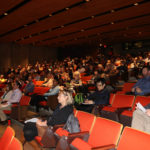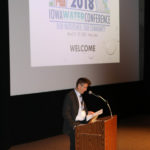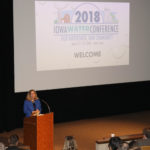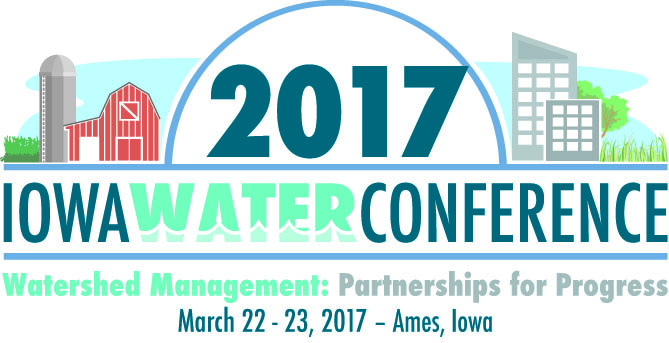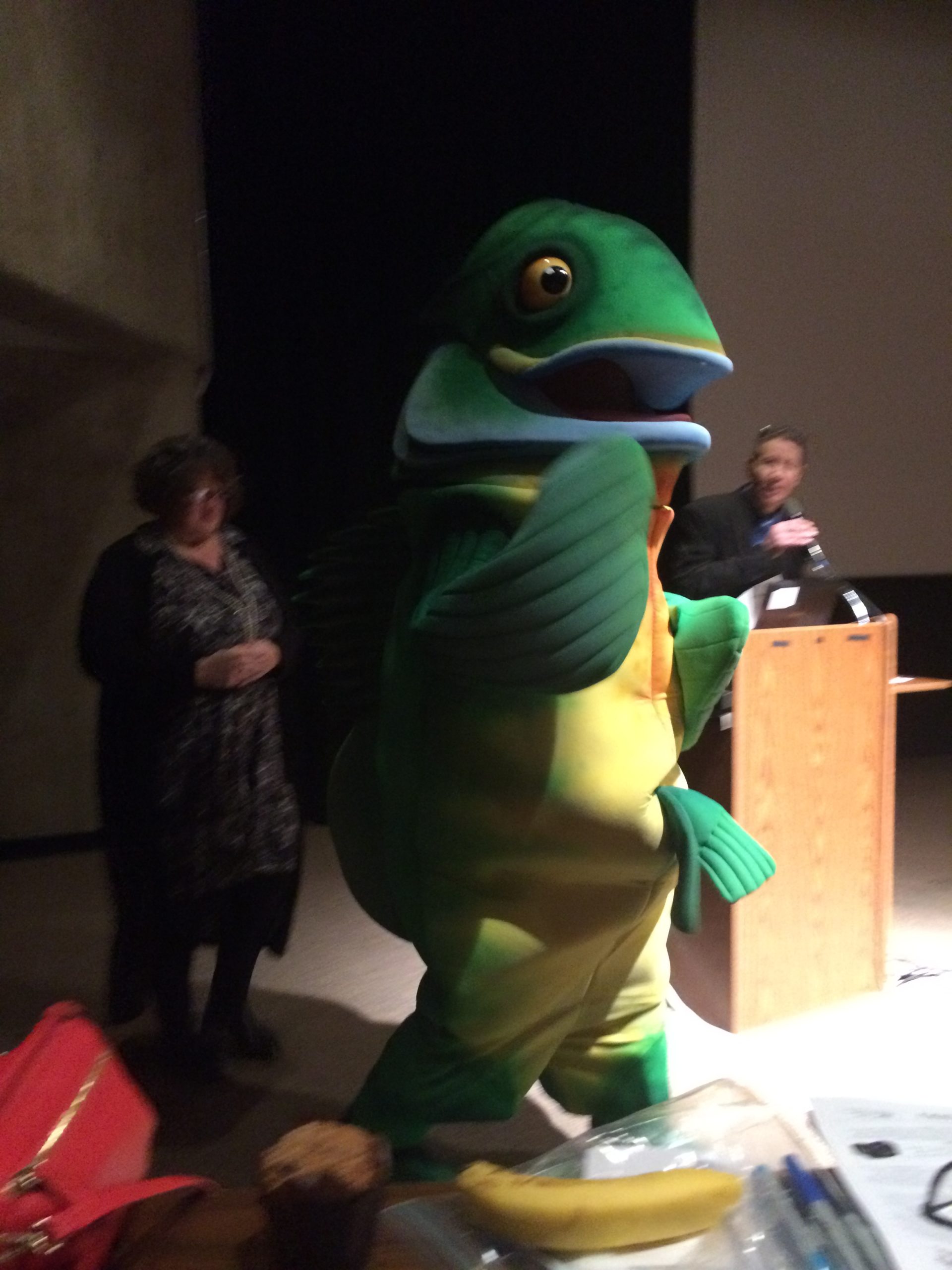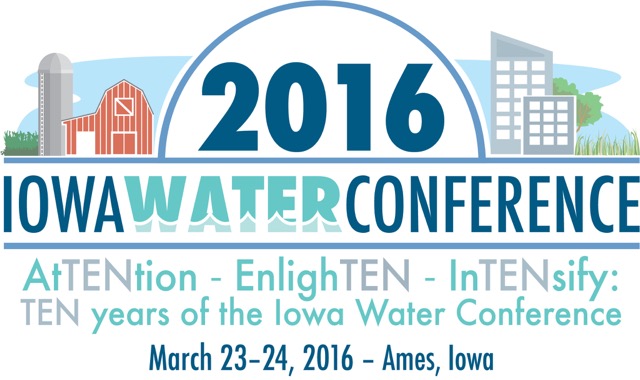Photos from the 2018 Iowa Water Conference. Photos by Hanna Bates, Program Coordinator at the Iowa Water Center.
The Realms of Flood Resilience: protecting our communities
Post submitted by Craig Just, assistant professor for the Department of Civil and Environmental Engineering at the University of Iowa and Ashlee Johannes, coordinator for the Iowa Watershed Approach Flood Resilience Program.
How can we become more flood resilient?
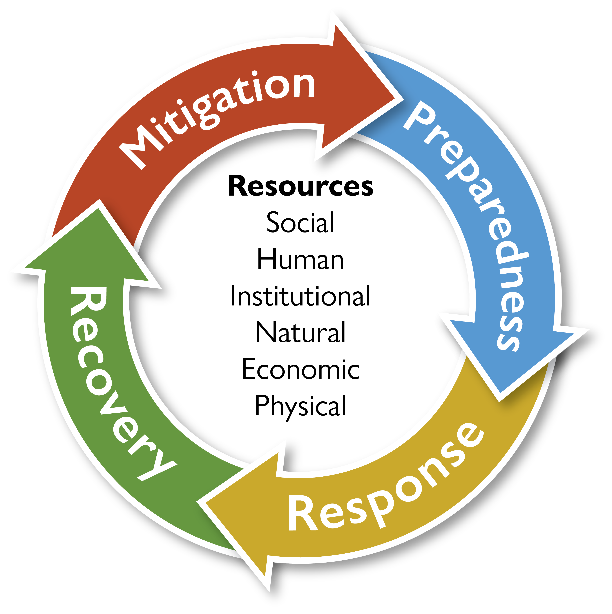 Community resilience is a recent desire for communities that face a serious disruption in their routine. But, what is resilience? A resilient community is able to mitigate, prepare for, respond to, and recover from an adverse event, including floods. The Iowa Watershed Approach (IWA) Flood Resilience Team views resilience in terms of six “resources”—social, human, institutional, natural, economic, and physical. A community’s resilience depends on its capacities in each of these areas, as well as the engagement and unity of its citizens.
Community resilience is a recent desire for communities that face a serious disruption in their routine. But, what is resilience? A resilient community is able to mitigate, prepare for, respond to, and recover from an adverse event, including floods. The Iowa Watershed Approach (IWA) Flood Resilience Team views resilience in terms of six “resources”—social, human, institutional, natural, economic, and physical. A community’s resilience depends on its capacities in each of these areas, as well as the engagement and unity of its citizens.
During the first year of the IWA, the Flood Resilience Team trekked 10,000-miles, crisscrossing the state of Iowa and visiting diverse watershed communities to recognize their progress and understand their hurdles towards building a resilient community. In the process, our team observed a common resource that was missing in their actions: social resilience. Social resilience, at a community scale, is challenging to describe and quantify, so we have committed our focus to this topic. Our flood resilience programming has three goals that all strive towards improving social resources, and other resilience resources, for the IWA watersheds: 1) measure, visualize, and communicate flood resilience resources; 2) enhance flood resilience content in formal watershed plans; and 3) improve social resources of flood resilience.
A critical action for the Flood Resilience Team is the creation of interactive maps that display social vulnerability at the intersections of flood risk for each IWA watershed. With this information, watershed representatives can identify areas of high social vulnerability (or lower resilience). Furthermore, users will be able to pinpoint the underlying drivers of the vulnerable area (e.g., prominently low-income neighborhoods, people with disabilities, large children population) for targeted outreach and emergency response purposes. We will also empower community planners to use this information to implement flood mitigation strategies that protect socially vulnerable populations.
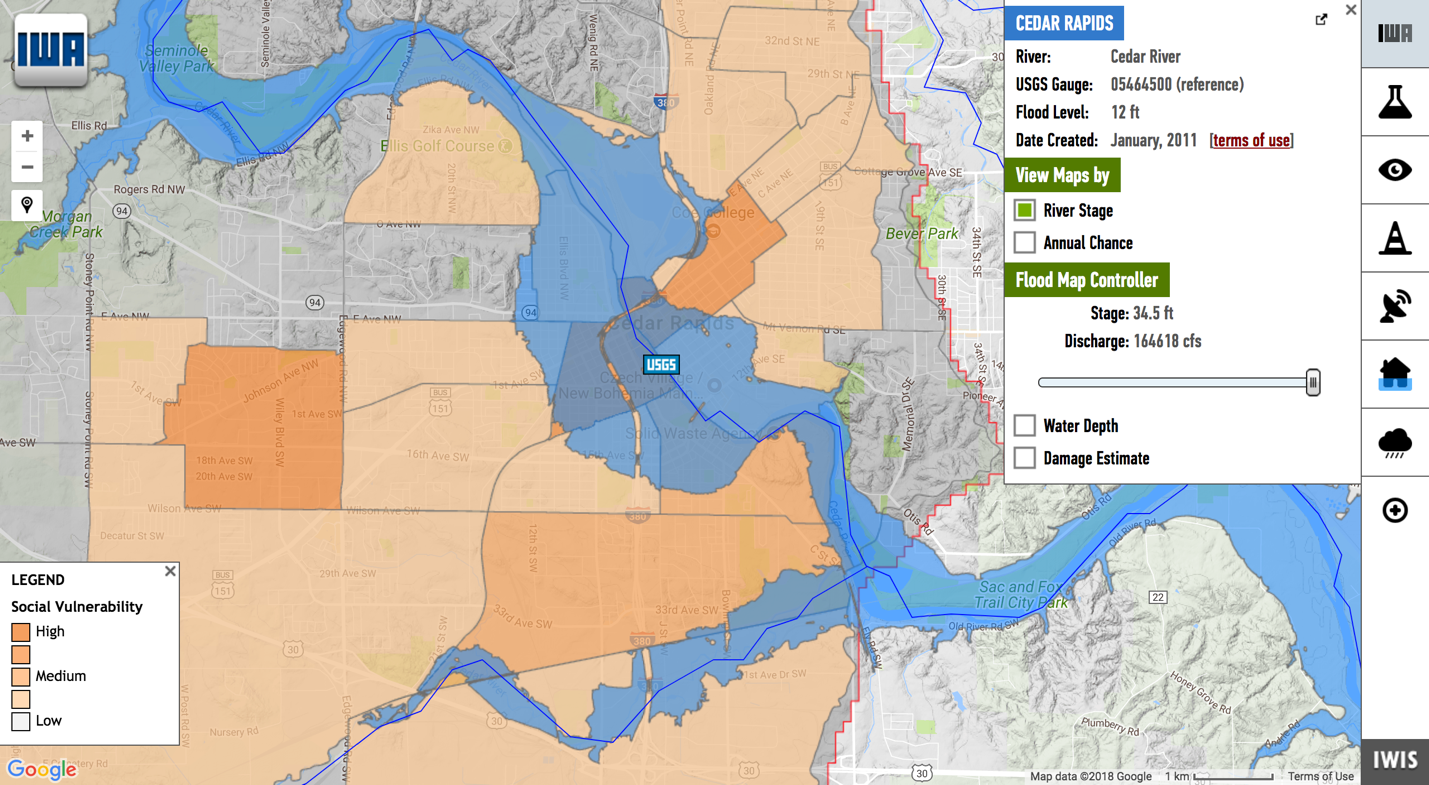
With assistance from IWA partners, the Flood Resilience Team is contributing to flood mitigation planning by connecting hazard mitigation and watershed plans to expand opportunities for other funding sources. To facilitate this process, damage and loss estimates to structures and their contents will be available online. This information, in addition to the social vulnerability maps, will be useful for emergency response, outreach, and planning purposes. To view the most recent version of these digital maps, visit: http://iwa.iowawis.org/.
Learn more about the IWA Flood Resilience Program at the Annual Iowa Water Conference on March 21-22 at the Scheman Building at Iowa State University in Ames. Lead presenter Ashlee Johannes will host a breakout session about the evolution of the flood resilience program and building a more resilient state.
Together, we can make our watershed communities more flood resilient. For more information about the IWA Flood Resilience Program, visit: http://www.iowawatershedapproach.org/programs/resilience/.
About the Authors:
Craig Just, PhD, is assistant professor for the Department of Civil and Environmental Engineering at the University of Iowa (UI). He is also an affiliate of the UI’s Water Sustainability Initiative. As the team leader of the Iowa Watershed Approach Flood Resilience Program, he develops and manages resilience programming actions and products.
Ashlee Johannes, MS, is the coordinator for the Iowa Watershed Approach Flood Resilience Program. She assists with product development, facilitates communication of the resilience programming activities, and fosters engagement with IWA watershed groups, partnering organizations, and other stakeholders.
Make a Suggestion for IWConf18
Recently, we announced the open call for presentations for the 2018 Iowa Water Conference. (There’s still time to submit your abstract – the deadline is September 4 at 11:59 p.m.!) We have had some great submissions thus far, and look forward to reviewing them with the Iowa Water Conference planning committee.
However, it occurred to us last week through some conversations at the Prairie Lakes Conference in Okoboji, IA that there may be a swath of good presentation suggestions sitting out there from people who wouldn’t want to volunteer other people (or themselves) without an invitation. While we ask for suggestions in the post-event evaluation, we historically have not actively solicited suggestions for speakers the rest of the year.
To solve this dilemma, we are introducing a new webform on the conference page on our website. Here, you can make suggestions of topics or speakers you’d like to see covered at the upcoming Iowa Water Conference. Keep in mind this is prime agenda developing season – we typically fill up the agenda by November 1 – so while we accept suggestions year-round, anything after the agenda is full will be considered for the following year.
Of course, you’re always welcome to chat with us as you see us out and about, or shoot an email directly to hbates@iastate.edu. Happy suggesting!
2018 Iowa Water Conference – Call for Abstracts!
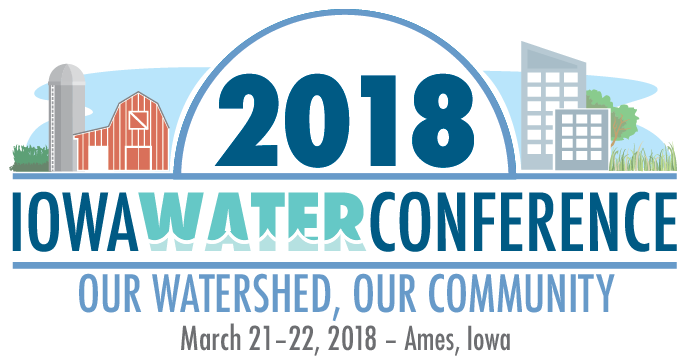
Success in water-related work, whether it is out in the farm field, a backyard, or in city infrastructure, cannot be achieved alone. It is done by a community and for a community. With that in mind, the Iowa Water Conference Planning Committee is happy to announce the theme for the 2018 Iowa Water Conference: “Our Watershed, Our Community.” This theme was inspired by the large, complex network of water-related professionals in Iowa that support local watershed work.
We invite water professionals, researchers, and graduate students to submit presentation abstracts centered around the theme of community in water. Through these presentations, applications should share success stories, challenges, and research that supports a foundation of community at the watershed-level.
The call for presentations, including instructions for submission, can be found here. Questions can be directed to Hanna Bates at hbates@iastate.edu. We look forward to learning about your watershed experience!
IWConf17 presentation applications are due (really) soon
If you’ve been putting off submitting an application to present at the 2017 Iowa Water Conference, put it off no longer – applications are due Sunday night (Aug 14) at 11:59 p.m. The IWConf17 planning committee will review in the weeks following as the “first cut” for determining the 2017 conference agenda.
(It’s okay if you wait until Sunday to submit. It’s not procrastination. You’re busy. It’s prioritization.)
Wondering if you should submit an application? Do you answer yes to any of the following questions?
-Do you have a story to tell about watershed successes?
-Are you looking for partners for a current or new project?
-Do you have the latest tool in your water management field with proven results?
-Have you figured out a way to engage new sectors of populations in water-related activities or conversations?
From the call for applications:
We’ve got news…
It’s been a little quiet around this old blog-that tends to happen in the aftermath of the Iowa Water Conference. A challenge we’ve always faced is limited staff – you’ll notice there are only two faces on our About Us page.
That’s about to change. Today, our posting for a program assistant went live on iastatejobs.com. As public interest in Iowa’s water management has heated up, so has the role we’re able to play in shaping Iowa’s water future. The Iowa Watershed Approach grant from the U.S. Department of Housing and Urban Development and increasing expansion of the Daily Erosion Project have put us in a place where we not only need more staff, we have the support to do so.
So what will the program assistant do? Lots of important stuff. Does that sum it up? Okay, to be more specific, this person will:
- administer our competitive grants program
- help with planning education and outreach events (including the Iowa Water Conference)
- keep track of the approximately 10 million details involved in managing IWC sponsored projects
- spread the word about all the fantastic water research and activities going on
We’re looking for a know-it-all. A details person. A deadline embracer. A communicator.
The posting is currently open through June 5. If you or someone you know are interested in this position, please review the job posting and submit through the Iowa State system. Want to talk it through? Call or email. We’re ready.
Reflections on the 2016 Iowa Water Conference
It’s been a week since the opening of the 2016 Iowa Water Conference, one of the most highly attended events in its ten year history. We’ve been busy tying up loose ends, getting presentations posted on the event page, and even catching a few breaths here and there. A week removed seems like a good time to record some observations about this year’s conference as we look forward to 2017 (yes, already!).
You can’t control the weather. We had the conference three weeks later this year to avoid the inevitable early March “in like a lion” happenings. Mother Nature pretty much laughed in our faces, since the weather at the beginning of March was gorgeous, and the storm Wednesday night prevented several attendees and three speakers from making it to Thursday’s activities. (Absolutely enormous thank you to ISU Brent Pringnitz for setting these speakers up to present remotely in an unbelievably short turnaround period.)
Water is kind of a big deal. We had almost 500 people attend the water conference this year. That’s 100 more than last year. We had more posters, more exhibitors. People care about water so much that they will take two days out of their busy schedules to come learn and talk about it with people they may or may not know. The opening plenary even got media coverage on WHO TV.
The Iowa Water Conference shouldn’t be the only time we collaborate. We’ve received feedback from many people who want to make sure the cross-pollination that the Water Conference fosters stays at the forefront. One way to do that is to plan or attend local conferences/meetings/seminars on more specific interests (like tomorrow’s IGWA meeting in Newton). If you need help planning, let us know – we can help steer you in the right direction. If you’re looking for events, sign up for our newsletter. If you have an event, send it to us and we’ll help promote it.
This is YOUR conference. We made quite a few changes to this year’s conference to reflect the comments left in the evaluations from last year, and from what we can tell, they worked (for the most part). Please continue to send us your ideas throughout the year. We’ll have an open call for presentations during the summer months; you’ll find the announcement on this blog, our newsletter and Facebook and Twitter. We have an amazing core committee of conference planners, but can always use more ideas and voices. If you or your organization might want to be on our list of planning partners, give us a call.
There is a lot more we can say, but we’ll leave it at that for now. What were your takeaways from the 2016 Iowa Water Conference?
Water research presentations at the Iowa Water Conference
In addition to the many breakout presentations already scheduled at the Iowa Water Conference, we’ll also offer a venue for recent water research to be presented. The following eight presentations have been scheduled:
Wednesday, March 23
Plans to Make Satellite Soil Moisture Work in Iowa
Brian Hornbuckle, Iowa State University Department of Agronomy
New satellites are producing maps of current soil moisture conditions. There are problems, however. A NASA-led field experiment will be conducted in Central Iowa this coming summer to address these issues. We will describe the experiment plan.
Effects of Some Phosphorus and Soil Conservation Management Practices on Dissolved and Total Phosphorus Loss with Surface Runoff
Antonio Mallarino & Mazaq U. Har, Iowa State University Department of Agronomy
Efforts are being developed at federal, state, and private levels to reduce the impact of agricultural practices on phosphorus (P) loss from fields and water quality impairment. This presentation will share results of recent and ongoing Iowa research that has been looking at how management practices such as the P rate and source as well as other conservation practices impact the amount and proportion of dissolved and particulate P loss with surface runoff.
Understanding the Diversity in Nutrient Management Practice Use in Midwestern Agriculture
Hanna Bates, Prairie Rivers of Iowa
Social science studies have shown that information access and social networks can affect nutrient management practice adoption. In this presentation, we ask: What is the relationship between different aspects of farmers’ social networks and the adoption of diverse nutrient management practices? Using 2012 Rural Life Farm Poll data, this presentation attempts to answer that question and explore implications for outreach and technical support strategies to farmers.
How Efficiently do Corn- and Soybean-based Cropping Systems use Water? A Systems Modeling Analysis
Ranae Dietzel, Iowa State University Department of Agronomy
Agricultural systems are being challenged to decrease water use and increase production while climate becomes more variable and the world’s population grows. This work looked at systems-level definition of water use efficiency that addresses both production and environmental quality goals through incorporating all major system water losses. It provides a framework to concurrently evaluate production and environmental performance of cropping systems.
Thursday, March 24
Getting Into Soil and Water Virtually with PEWI
Lisa Schulte Moore, Iowa State University Natural Resource Ecology and Management
Soil and water conservation are top priorities for Iowans, but we are challenged in how to achieve it. Trying new things is costly, which stymies creativity. This presentation discusses an online tool, PEW, developed to help overcome this hurdle.
Comparing the water-use and water-use-efficiency of biomass sorghum and maize in the rain-fed, Midwest, US
Matt Roby, Iowa State University Department of Agronomy
Climate variability and a projected increase in demand for non-grain ethanol feedstock may necessitate expanding the production of more water-use-efficient and less drought sensitive crops for biofuel applications in the Midwest, US. This research highlights the importance of understanding the potential effects of expanding biomass sorghum production on the hydrologic cycle of the Midwestern US.
Seasonal forecasting of discharge for the Raccoon River at Van Meter, Iowa
Gabriele Villarini, University of Iowa IIHR-Hydroscience and Engineering
The state of Iowa is regularly afflicted by severe natural hazards such as the 2008/2013 floods and the 2012 drought. To improve preparedness for these catastrophic events and allow Iowans to make more informed decisions about the most suitable water management strategies, we have developed a framework for medium to long range probabilistic seasonal streamflow forecasting for the Raccoon River at Van Meter, a 8900-km2 catchment located in central-western Iowa.
Assessment of Flood Mitigation Strategies for the City of Kalona, Iowa
David Koser, University of Iowa IIHR-Hydroscience and Engineering
In order to reduce flooding, communitites often try to control runoff with a storm sewer network, detention basins, low impact developments, and upstream storage to reduce stream overflow. A couple 1D/2D hydraulic model using XPSWMM was created for the town of Kalona, IA, to test different strategies for flood reduction.
Waxing poetic about working together (and NIWR)
In the water world, we talk a lot about working together. We all live in a watershed. The importance of partnerships. Work with your upstream neighbor to improve life downstream.
Sometimes, all it is, is talk. We say we want to work together, but it doesn’t happen, for whatever reason – maybe we can’t get together, we get busy with other things, we can’t agree on priorities. But the reason we talk about working together in water is because we do all live in a watershed. Working with your upstream neighbor DOES improve life downstream. Partnerships aren’t only important, they’re vital to success, and when we work together, impactful things happen.
Last week, 49 of the 54 Water Resources Research Institutes got together for the annual director’s meeting. The Virginia Water Resources Research Center planned the meeting this year (we had the honor last year) and for three days, we worked together.
A few droplets that represent the bigger “working together” stream:
-49 out of 54 WRRIs were in attendance. The meeting was in Washington, DC. The Virgin Islands made it. Alaska made it. Even Guam made it. (Actually, Guam director Shahram Khosrowpanah is a valued member of the NIWR board.) Distance didn’t preclude the Institutes from getting together.
-We heard from federal representatives that told us water resources research is headed toward the funding of collaborative, interdisciplinary research – multifaceted projects that address water resources not just from a technical perspective but also from a human dimension perspective. Water resources management IS the proverbial Big Picture. Research will treat it as such.
-Over a period of 24 hours, the Iowa, Illinois, and Tennessee Institutes went from chatting over a few sandwiches about potentially working on a regional effort to planning, identifying, and putting into action a plan to work with USGS Water Science Centers in our state and region to focus on making a difference in the Mississippi River basin. (More on that as it develops.) All three states have different priorities and run their Institutes a little differently, but we all have one goal.
This meeting was, and always is, a short period of time in which we focus on what it means to work together. Iowans, you have an opportunity to do the same thing next month at the Iowa Water Conference. Use the conference to not only learn about the latest in water management in Iowa, but to find people and organizations with whom you can work together. Work with your upstream neighbor; you WILL improve downstream. Partnerships ARE important. And for goodness sake, we all live in a watershed!
Registration open for 2016 Iowa Water Conference
It’s here! It’s perhaps one of the best days of the year over here at the Iowa Water Center! Registration has opened for the 2016 Iowa Water Conference. There is an overwhelming amount of information on the conference website, so scurry over there and take your time checking everything out. Some of the highlights:
- $150 regular/$75 student registration – ends March 11. Add $25 for late registration.
- $50 optional workshop – “The Psychology of Sustainable Behavior: A skill building workshop to support voluntary behavior change”
- $500 commercial exhibits/$50 nonprofit exhibits – commercial exhibits include one registration
- Poster registration is online again this year (there’s a big red button on the bottom to start registration)
Have any questions about this year’s conference? Call Melissa Miller at 515-294-7467 or send an email to millerms@iastate.edu. Can’t wait to see you in March!
P.S. If you see anyone from any of the following organizations, give them a pat on the back for their hard work in helping plan this year’s conference: Iowa Association of Municipal Utilities, Iowa Department of Agriculture and Land Stewardship, Iowa Department of Natural Resources, Iowa Flood Center, Iowa Floodplain and Stormwater Management Association, Iowa State University Extension and Outreach, Iowa Storm Water Education Program, Leopold Center for Sustainable Agriculture, Luther College, Natural Resources Conservation Service, Trees Forever and the U.S. Geological Survey — Iowa Water Science Center.
